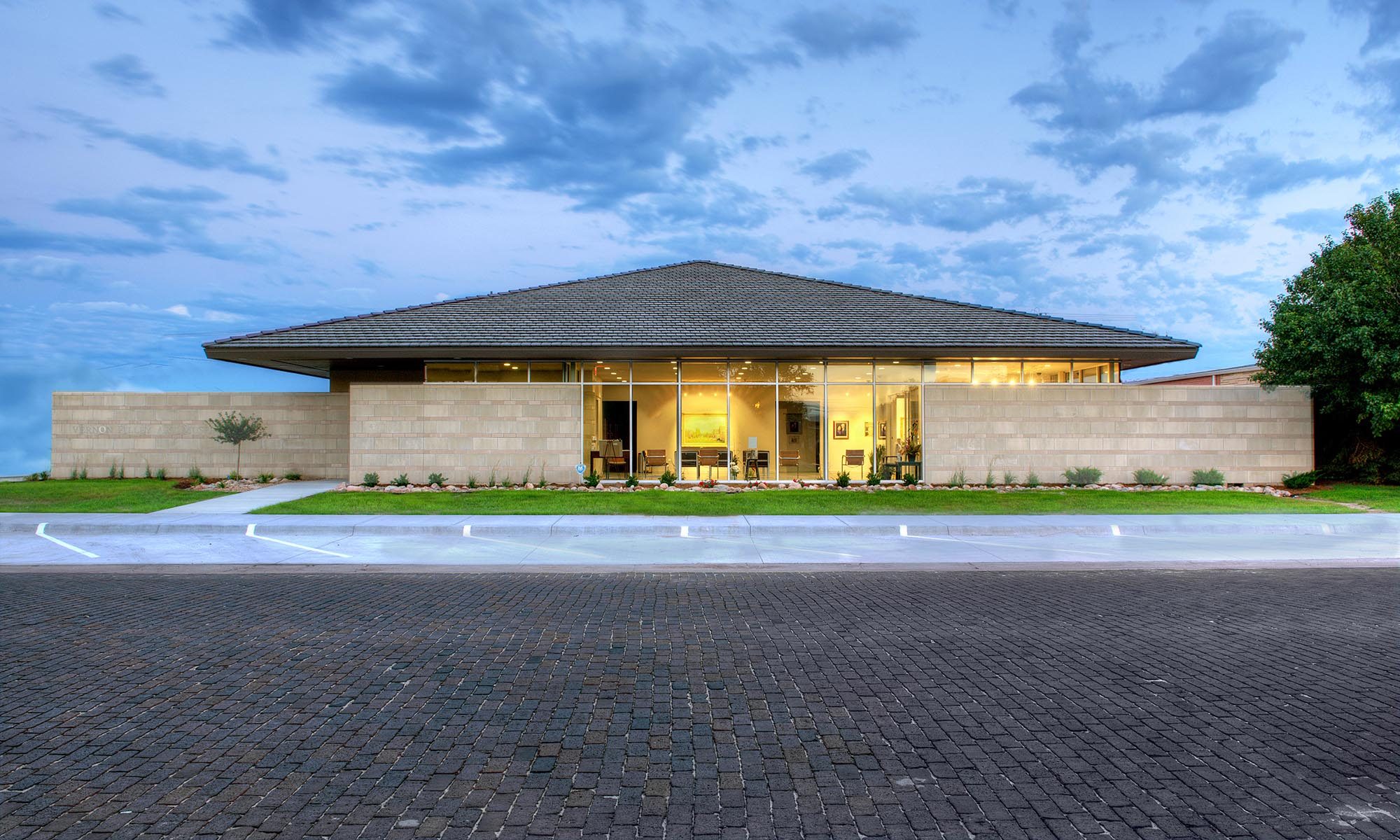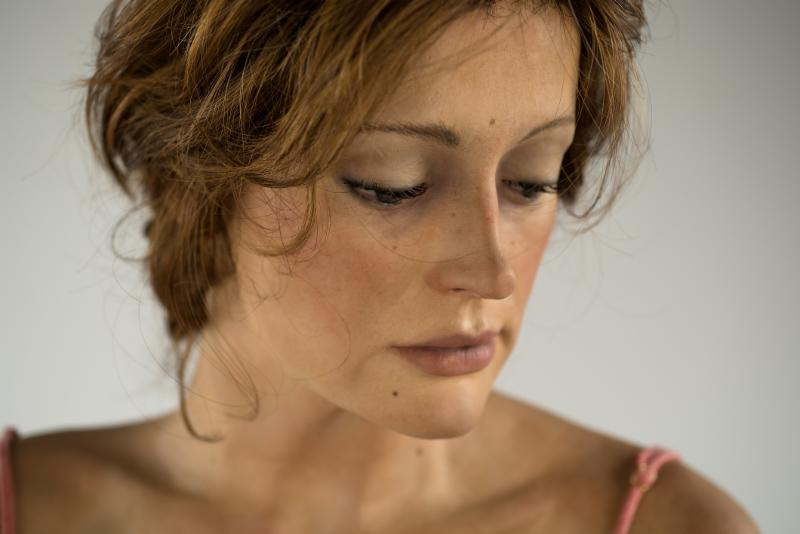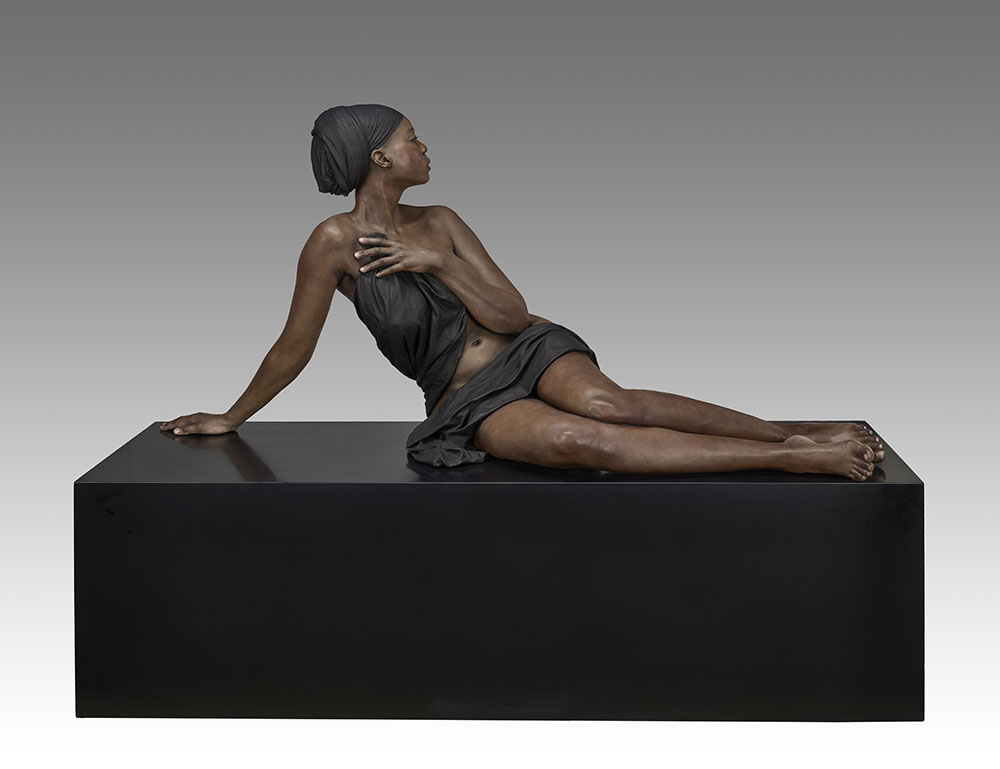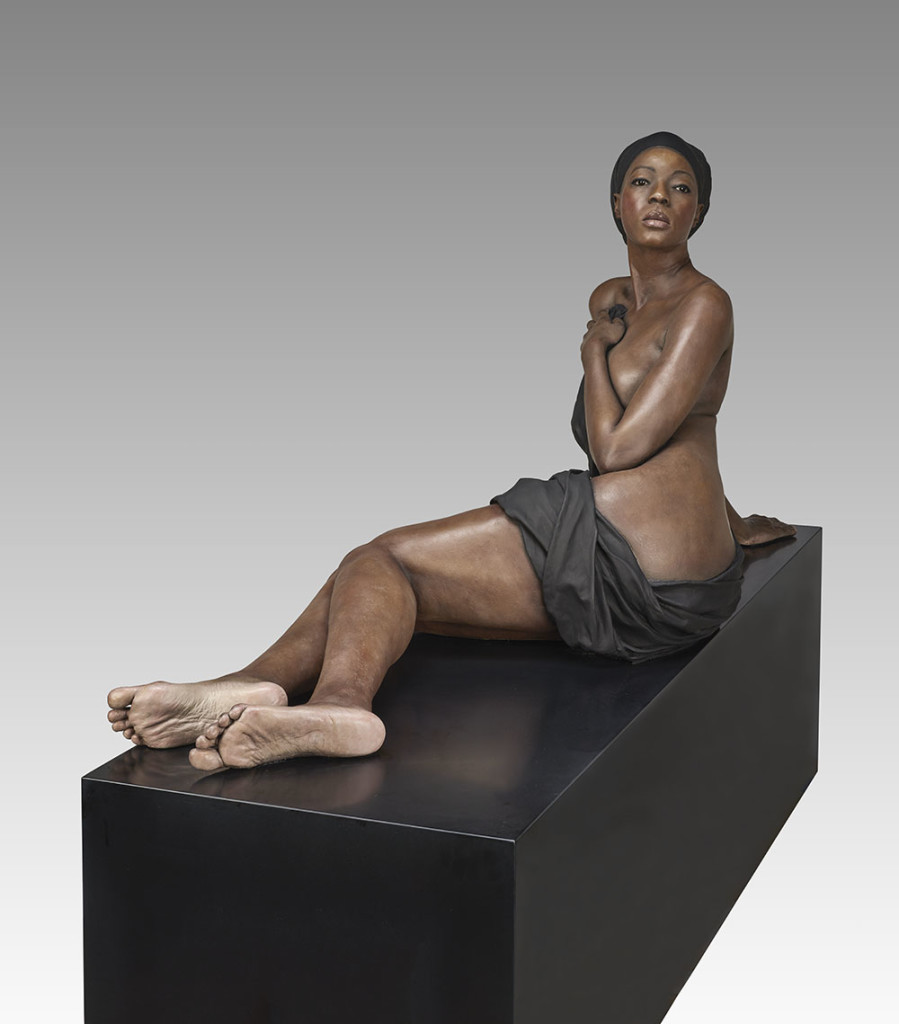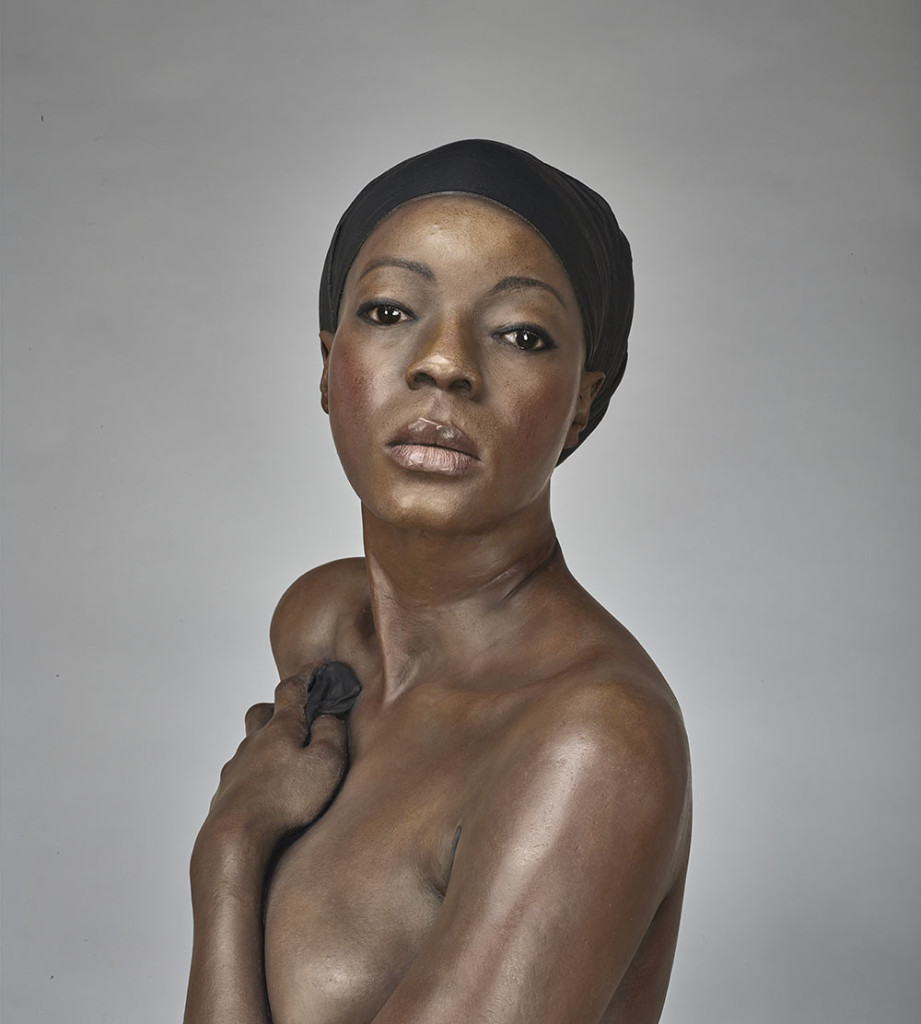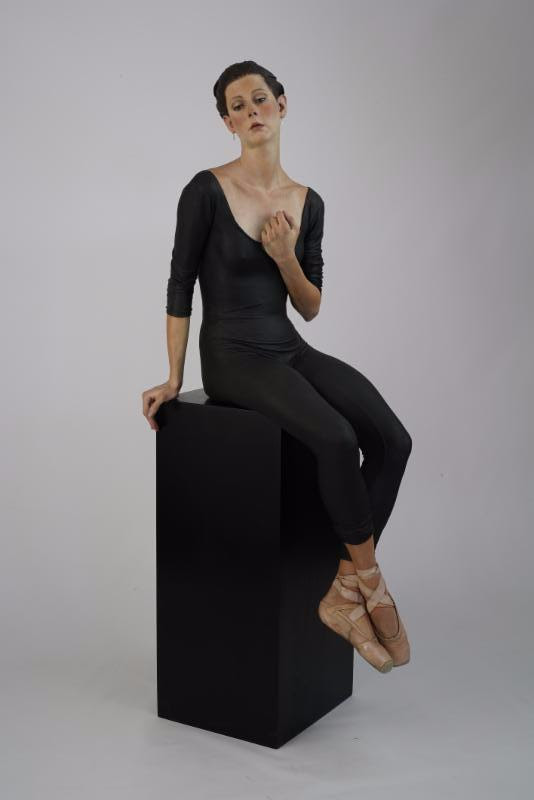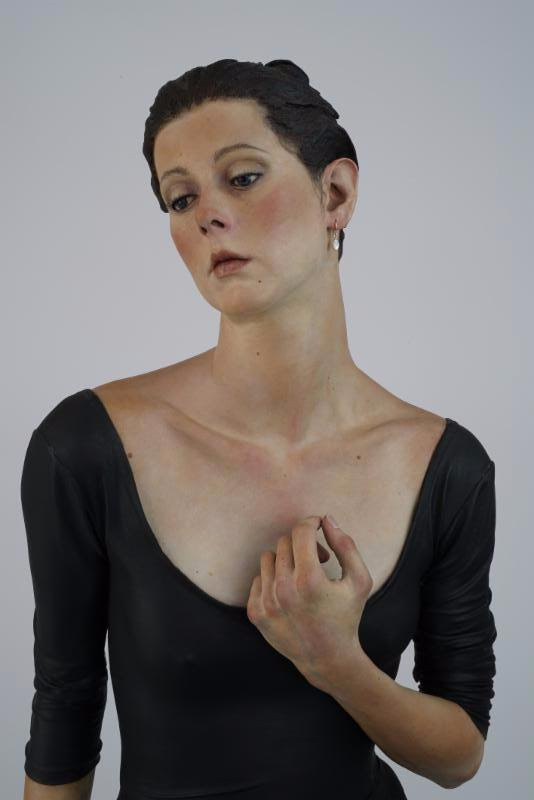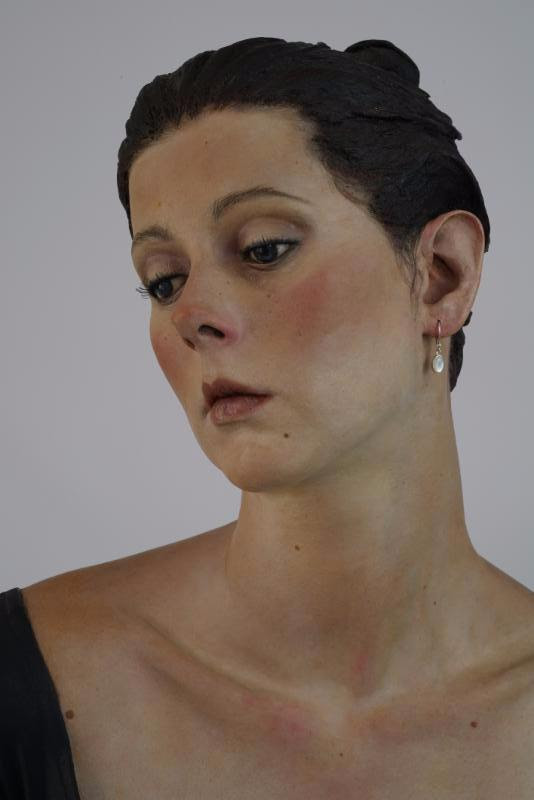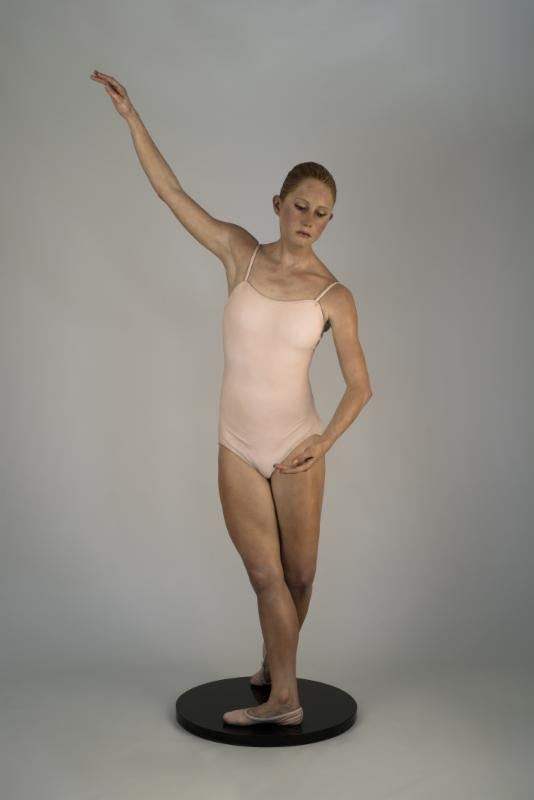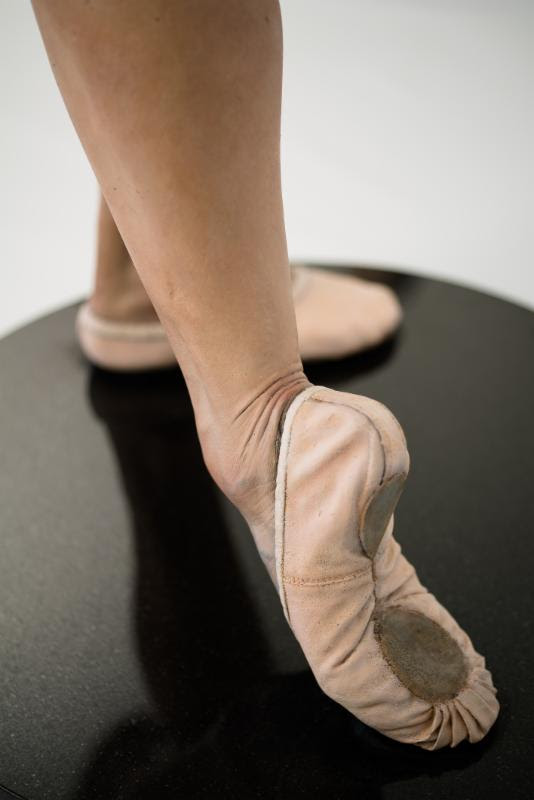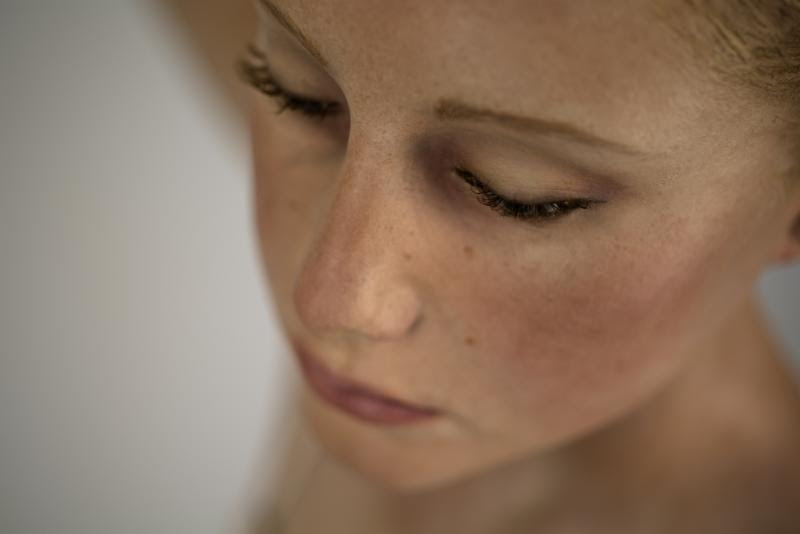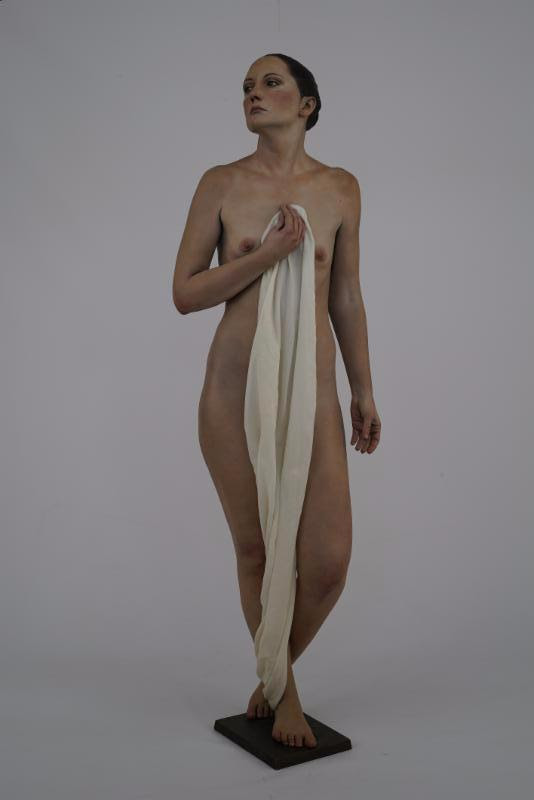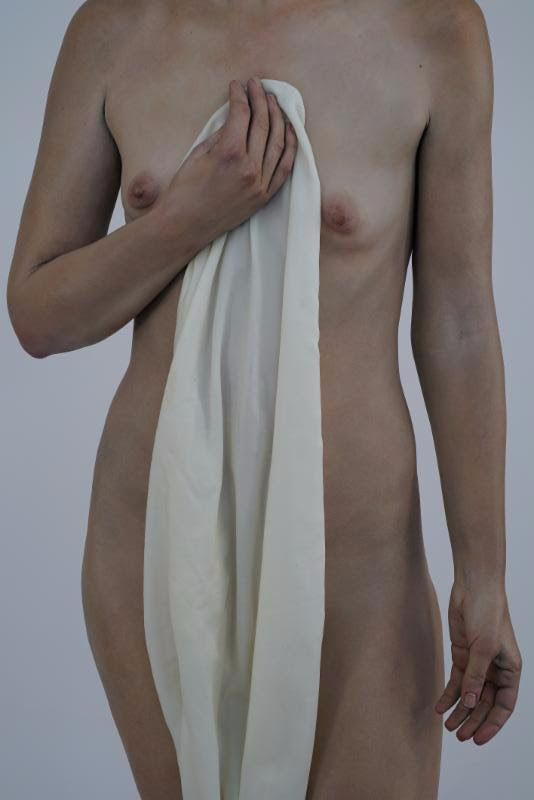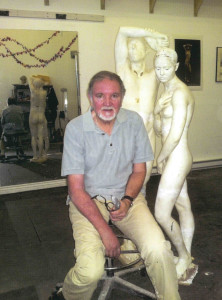
Thanks to the generosity of our guest artists, this exhibition has been organized as a fundraiser for the Filley Art Museum!
All Photographs by Shivayam Ellis, All sculptures are life-sized
Call 620.933.2787 or email info@vernonfilleyartmuseum.org for more information or inquiries on purchases. Please come visit us in person to see the full exhibition and experience the artwork personally while they are on display at The Filley! 40% of sales are donated to the art museum (which is tax deductible for those who purchase artwork during this show).
Click here to view work by Ariel DeAndrea in the current exhibit!
John DeAndrea Biography and Artists Statement:
JOHN DEANDREA
“If I could make it breathe I’d say ,‘I’ve done a good day’s work.’”
—John De Andrea
Excerpts below are from an essay by: Jane Fudge
Galatea and Company
Good form does not show. A statue representing a woman is a woman, not the shape of a woman – this holds true for a Roman Venus or a Gothic Madonna, and also for an African wood carving or the reclining figures of Henry Moore. And, in fact, even the woman…disappears in order to leave only the pure visual embodiment of meaning or character. If, instead of meaning and character, you see a human body in the flesh, or if, instead of the human body, you see formal relations, something is wrong with the figure.
-Rudolph Arnheim, Toward a Psychology of Art.
“I always believed in the real thing,” sculptor John DeAndrea says of his ultra life-like work, “If I could make it breathe I’d say ‘I’ve done a good day’s work now” For more than 40 years, John DeAndrea sculpture has extended realism, his inheritance from ancient Greece and Renaissance Italy, to its extreme. His figures remain the last word in illusionism, enduring chilly gallery settings with serenity.
Yet the artist’s own myth is Promethean. His is the legend of the creator who challenges the Gods themselves to favor or condemn his intentions. Daedelus makes a statue of a hero so life-like that Hercules takes it for a rival and knocks it down. Aphrodite breathes life into Pygmalion’s ivory Galatea. There are Dr. Frankenstein’s furtive experiments and Coppelius’s wonderful doll.
DeAndrea’s astonishingly realistic figures are cast from life and rendered in minute detail. Hair is set into bronze scalps, brows, and body hair a few strands at a time. The oil polychrome “skins” reveal moles, tiny veins, and scars. For draped works, garments are taken apart and reassembled on the fully painted bodies. In the nudes, pressure marks on the flesh made by clothing are preserved in the casting material.
These amazing simulacra are among the most enduring legacies of Photorealism, and they have gained John DeAndrea an international reputation. Usually the viewer’s first reaction to DeAndrea’s work is shock at seeing an unclothed person in the decorus space of museum or gallery. If there were nothing beyond the startling evocation of the Human gestalt, DeAndrea’s figures would offer only superficial, transient, and vaguely erotic sensation. They would be three-dimensional pinups, but they are not. DeAndrea’s work has an abiding fascination that derives from the way it reconciles apparently conflicting esthetic tendencies.
On one hand, much of DeAndrea’s work perpetuates the artistic tradition of the idealized nude. Amber Reclining is one of the long-legged, high-breasted Aphrodites revered by the Greeks, and the recumbent nymphs and goddesses of Titan and Giorgione. DeAndrea continues this tradition by choosing youthful models who are slim and well muscled. They are individuals whom nature has fashioned close to the Western canon of beauty.
On the other hand, the fact that the sculptures are cast directly from the models’ bodies ensures that every birthmark and wrinkle, every flaw, however small, will be reproduced in bronze and paint. This insistent individualism and deviation from perfection run counter to every notion of an ideal art. Realism is by definition opposed to idealism, yet they harmonize in John DeAndrea’s work.
In the most fundamental sense of the term, DeAndrea’s art is also Classical. His sculptures are direct descendants of the rouged, gilded, and waxy idols we know (though we scarcely believe) the great stone sculptures of Classical antiquity to have been when new. The artist’s sensibility is at the same time peculiarly Mediterranean—another paradox for this is an anti-Classical tendency-and his figures likewise are relaxed to the illusionistic madonnas and saints of Spain, Italy, and Mexico with their “real” clothes and hair, and crystal tears. However, DeAndrea’s figures are wholly secular, with none of the sentimental passion that typifies these religious images.
Indeed, the poignancy of DeAndrea’s sculpture derives from its very coolness, its lack of eros. Dressed or naked, the figures make no attempt to engage the viewer. Even those with energetic or agonized poses remain self-contained, introverted. Eyes are downcast or closed—or look into an indefinite middle distance as if their world is another dimension in which the visitor has no reality. Even the exquisite Ariel I gazes upward longingly bur with reserve. It is as if these enigmatic icons meditate on what the flesh—that is, our flesh—is heir to.
A Denver native, DeAndrea studied foreign languages and art at the University of Colorado at Boulder. In undergraduate school he mostly painted. He admired the work of San Francisco Bay Area artists like Nathan Oliviera and sculptor Manuel Neri. Although his practical experience in building and remodeling made him feel more comfortable working in three dimensions, sculpture remained a sideline almost until the end of his undergraduate days.
On finishing his work in Colorado, DeAndrea got an assistantship at the University of New Mexico in Albuquerque. He had already made a few plaster body casts in Boulder and experimented with pouring them up in wax and other unsuitable materials. He learned the use of fiberglass for making positives from a friend who built kayaks in New Mexico. “When I got a piece to come out of the mold,” DeAndrea recalls, “it was like an archaeological dig. The figure wasn’t the color of a person, but it was very like a person—the shape of the limb, the texture of the skin.”
As he did not want a college teaching career that graduate school was preparing him for, DeAndre left Albuquerque with a carload of fiberglass “body parts” and returned to Denver. He first attempted to finish the surfaces of his plastic “people” with automotive paint. When a friend casually suggested that DeAndrea might color his figures in flesh tones, he began coating them with hand-tinted latex. The effect was convincing, but the surfaces were incredibly fragile. He switched to oil paint which he still uses. The illusion of lifelikeness was soon augmented with natural hair and glass eyes.
Throughout much of his career, John DeAndrea has been represented by Ivan Karp’s OK Harris Works of Art in New York City. In the late 1960’s, DeAndrea sent Karp photographs of his realistic work and later a couple of pieces. Karp did not immediately realize that the sculptures were cast from life, but he was seeing a widespread, apparently unconnected renaissance in illusionism and trompe l’oeil work—shortly to be dubbed Photorealism, or Superrealism, or Sharp-focus Realism, depending on which publication you read.
Karp was already in touch with painter Ralph Goings and DeAndrea’s “social superrealist” counterpart, the late Duane Hanson. DeAndrea first mounted a one-artist exhibition at OK Harris in 1970, and since then has shown his work worldwide.
From time to time, after attaining an extraordinary degree of illusionism, DeAndrea has shifted to the formal rigors of black-and-white painting, doing figures clothed and nude, groups, and even self-portraits in grisaille. The tones of black, white, and gray emphasize the abstract qualities of the sculptures and relate them to two-dimensional images reproduced in magazines, on television, or in art books.
-Jane Fudge is a visual art and film critic, and is the former assistant curator of Modern and Contemporary Art at the Denver Art Museum
BORN
November 24, 1941; Denver, Colorado
RESIDES
Denver, Colorado
EDUCATION
1968 University of New Mexico at Albuquerque
1966 Awarded Art scholarship
1965 University of Colorado at Boulder, BFA
INDIVIDUAL EXHIBITIONS
1970 O.K. Harris Works of Art, New York, NY
1971 O.K. Harris Works of Art, New York, NY
1972 Wilmaro Gallery, Denver, CO
1973 O.K. Harris Works of Art, New York, NY
1976 O.K. Harris Works of Art, New York, NY
1981 Tortue Gallery, Santa Monica, CA
1982 The Aspen Center for the Visual Arts, Aspen, CO
1982 Foster Goldstrom Fine Arts, San Francisco, CA
1982 O.K Harris Works of Art, New York, NY
1985 O.K. Harris Works of Art, New York, NY
1985 Galerie Isy Brachot, Paris, France
1986 Galerie Isy Brachot, Paris, France
1987 Carlo Lamagna Gallery, New York, NY
1988 Galerie Isy Brachot, Paris, France
1988 Galerie Isy Brachot, Brussels, Belgium
1989 Carlo Lamagna Gallery, New York, NY
1991 ACA Galleries, New York, NY
1993 ACA Galleries/Munich, Munich, Germany
1996-97 John DeAndrea, Denver Art Museum, Denver, CO
1998 O.K. Harris Works of Art, New York, NY.
Ron Judish Fine Arts, Denver, CO
Modernism, San Francisco, CA
Bernaducci.Meisel.Gallery, New York, NY
2000 Ron Judish Fine Arts, Denver, CO
2001 Modernism, San Francisco, CA
Ron Judish Fine Arts, Denver, CO
2006 Louis K. Meisel/Bernaducci.Meisel.Gallery, New York, NY
2011 Louis K. Meisel/Bernaducci.Meisel.Gallery, New York, NY
SELECTED GROUP EXHIBITIONS
1970 Annual Exhibition, The Whitney Museum of American Art, New York, NY
1970 Radical Realism, The Museum of Contemporary Art, Chicago, IL
1971 Biennale, Paris, France
1971 Radical Realism, Museum of Contemporary Art, Chicago, IL
1971 Kunstmarkt, Cologne, Germany
1971 Old Realism, New Realism, Dannenberg Gallery, New York, NY
1972 Documenta V; Kassel, Germany
1972 Sharp Focus Realism, Sidney Janis Gallery, New York, NY
1972 Hyperrealistes Americains, Galerie des Quatre Mouvements, Paris, France
1972 Recent Figurative Sculpture, Fogg Art Museum, Harvard University,
Cambridge, MA; traveling exhibition
1972 Art Institute of Chicago, Chicago, IL
1972-73 Realist Revival, New York Cultural Center, New York, NY
1973 Amenkansk Realism,Lunds Konsthall, Sweden.
1973 Realism Now, Lunds Kunsthall, Lunds, Sweden
1973 Grands Maifres Hyperrealistes Americains, Galerie des Quatre Mouvements, Paris, France
1973 The Super-Realist Vision, DeCordova Museum, Lincoln, MA
1973 The Male Nude, Emily Lowe Gallery, Hofstra University, Hempstead, NY
1974 Hyperrealistes Americains/Realistes Europeans, Centre National d’Art Contemporain, Paris, (toured Europe)
1974 New Photo Realism, Wadsworth Atheneum, Hartford, CT
1974 The Real and Ideal in Figurative Sculpture, Museum of Contemporary Art, Chicago, IL
1974 Living American Artists and the Figure, Pennsylvania State University, University Park, PA
1974 Museum of Contemporary Art, Chicago, IL
1975 Photo-Realist Art, Edwin A. Ulrich Museum of Art, Wichita State University, Wichita, KS
1976 Aspects of Realism, Rothman’s of Pall Mall traveling exhibition, Stratford Art Gallery, Ontario, (toured Canada 1976-78)
1976 Super Realism, Baltimore Museum of Art, Baltimore, MD
1976 Aspects of Realism, Centennial Museum, Vancouver, Canada; traveling exhibition
1976 Perspective 1976, Freedman Art Gallery, Albright College, Reading, PA
1976 American Salon des Refuses, Stamford Museum and Nature Center, Stamford, CT
1977 The Nude: Avery and the European Masters, Borgenicht Gallery, New York, NY
1977 No Thing But Nudes, The Whitney Museum of American Art, New York, NY
1977 New Realism, Jacksonville Art Museum, Jacksonville, FL
1977 Art ’77, Hamilton College, Clinton, NY
1977 Contemporary Figuration, University Gallery of American Art, New York, NY
1977-78 Illusion and Reality, Australian National Gallery, Canberra, (toured Australia)
1978 Venice Biennale, Venice, Italy
1978 Selected 20th Century American Nudes, Reed Art Gallery, New York, NY
1979 Seven on the Figure, Pennsylvania Academy of the Fine Arts, Philadelphia, PA
1980 The Reality of Illusion, Denver Art Museum, Denver, CO (traveling)
1980 Illusionism, O.K. Harris West, Scottsdale, AZ
1980 Radical Realism, Center for the Arts, Muhlenberg College, Allentown, PA
1981 Contemporary American Realism Since 1960, Pennsylvania Academy of the Fine Arts, Philadelphia, PA
1982 Homo Sapiens: The Many Images, Aldrich Museum, Ridgefield, CT
1982 Real, Really Real, Super Real, San Antonio Museum of Art, San Antonio, TX (traveled to Indianapolis, Tucson,
and Pittsburgh)
1982 Documenta V1I, Kassel, Germany
1983 Faces Since The 50’s: A Generation of American Portraiture, Center Gallery, Bucknell University, Lewisburg, PA
1983 Contemporary American Realism, Foster Goldstrom Gallery, Dallas, TX
1984 Ten Years of Collecting at the MCA, The Museum of Contemporary Art, Chicago, IL
1984 Games of Deception: When Nothing is at it Appears, Artisan Space, The Fashion Institute of Technology, New York, NY
1984 Image, Effigy, Form: Figurative Sculpture, University Art Museum, California State University,
Long Beach, CA
1984 Figurative Sculpture: Ten Artists/Two Decades, University Art Museum, California State University, Long Beach, CA
1984 In Celebration, Tortue Gallery, Santa Monica, CA
1985 Fortissimo! Thirty Years from the Richard Brown Baker Collection of Contemporary Art, Museum of Art, Rhode Island School of Design, Providence, RI (traveling)
1985 The Classic Tradition in Recent Painting and Sculpture, Aldrich Museum of Contemporary Art, Ridgefield, CT
1988 Figure it Out: Visual Body Language, Helander Gallery, Palm Beach, FL
1988 Nude or Naked Vered Gallery, East Hampton NY
1992 Images of Man: Figures of Contemporary Sculpture, Japan Traveling Exhibition: The Isetan Museum of Art, Tokyo;
Daimura Museum, Osaka; Hiroshima City Museum of Art, Hiroshima
Summer Group Show, ACA Galleries, New York, NY
1997 An Assessment of Contemporary Figuration, David Klein Gallery, Birmingham, MI
1997 Feminine Image, Nassau County Museum of Art, Roslyn Harbor, NY
1997-98 Faces & Figures, Nassau County Museum of Art, Roslyn Harbor, NY
1999 7 Women 7 Years Later, Andrea Rosen Gallery, New York, NY
Three Realist Sculptors: George Segal, Duane Hanson, John DeAndrea, Nassau County Museum
of Art, Roslyn Harbor, NY
2000 The Photorealists, Holmes Gallery, Center for the Arts, Vero Beach, FL
2001 Figure it Out, Louis K. Meisel Gallery, New York, NY
2002 Summer of the Nude Vered Gallery, East Hampton NY
2002 The Nude In Three Dimensions, Louis K. Meisel, New York, NY
2003 Iperrealisti, Chiostro del Bramante, Rome, Italy
2004 Photorealism: Painting and Sculpture, Nassau County Museum of Art, Roslyn Harbor, NY
2004 Convincing Illusions, Louis K. Meisel Gallery, New York, NY
2004 Some Photorealism, Louis K. Meisel Gallery, New York, NY – May 8 – 27
2006 New Bronzes, Bernarducci.Meisel.Gallery, New York, NY – November 2 – 22
2008 The Grand Illusion, Louis K. Meisel Gallery, New York, NY – March 29 – April 26
2009 Figure 8, Bernarducci.Meisel.Gallery, New York, NY
2010 Expansion, Bernarducci.Meisel.Gallery, New York, NY
Real: Realism and Diverse Media, Imago Galleries, Palm Desert, CA
BOOKS / CATALOGUES
Hyperrealistes Americains/Realistes Europeens, exhibition catalogue, Paris, 1974.
Aspects of Realism, exhibition catalogue, Stratford, Ontario, 1976.
Neue Formen des Realismus by Peter Sager, Cologne, 1974
John de Andrea: Sculptures 1978-81, exhibition catalogue with essay by Philip Yenaivine, Aspen, CO, 1982.
Images of Man: Figures of Contemporary Modern Sculpture (1970-1990), exhibition catalogue with essay by Dr Martin H. Bush, Isetan Museum of Art, Tokyo, and Daimaru Museum, Umeda-Osaka, Japan.
John De Andrea, exhibition catalogue with essay by Dr. Martin H. Bush, ACA Galleries, NY, 1993.
Feminine Image, Nassau County Museum of Art, Roslyn Harbor, NY; Introduction: Constance Schwartz. Franklin Hill Perrell, 1997.
Faces & Figures, Nassau County Museum of Art, Roslyn Harbor, NY; Introduction: Constance Schwartz, 1997.
Three Realist Sculptors: Segal, Hanson, de Andrea, Nassau County Museum of Art, Roslyn Harbor, NY; Text: Franklin Hill Perrell, 1999.
Photorealsim: Painting and Sculpture, Nassau County Museum of Art, Roslyn Harbor, NY; Text: Franklin Hill Perrell, 2004.
La Maquina Contemporanea, ed. Antonio Lopez, Coedis Museumline, Murcia, Spain, 2005. Panzanelli, Roberta, ed.
The Color of Life: Polychromy in Sculpture From Antiquity to the Present. Los Angeles: J. Paul Getty Museum and the Getty Research Institute, 2008. 172-173.
PERIODICALS
“A New Realism in Sculpture”, by Grace Glueck in Art in America (New York), December 1971.
“Downtown Uptown, Not 10th Street”, by John Perrault in The Village Voice (New York), December 1971.
“Art in the Artist”, by Emily Genauer in The New York Post, December 1971
“They Only Look Like Photographs”, by Daniel Wells in The Chicago Tribune, May 30,1971.
“Exhibition of Radical Realism Chilling”, by Don Anderson in the Chicago Today, June 13,1971.
“Neutral Style”, by Edward Lucie-Smith in Art and Artists (London), August 1975.
“Hyper-Realistic Dreikiang”, in Du (Zurich), July 1979.
“New York Commentary: Realism Again”, by Dore Ashton in Studio International, (New York), March 1972.
“Look Alive!”, by Rosalind Constable in The Saturday Review, April 1972.
“Direct Cast and Sculpture”, by Carl Goldstein in Arts, January 1972.
“The Corn Realist as God”, by Robert Hughes in Time, January 1972.
“Remarks on the Nude”, by Carter Ratchif in Art International, March 1977.
“De Andrea”, by Jean-Louis Ferrier in Le Point, (Paris) September 1985.
“Real Dead” by Richard Kalina in Arts Magazine, December 1991
“Bir New York Galericisi: Ivan Karp”, Gencsanat, (Turkey), May 1998
2006 American Art Collector, pp. 148-151, ills, col., November
1991 Kalina, Richard. “Real Dead” Arts Magazine, December
1985 Ferrier, Jan-Louis. “DeAndrea”, Le Point, September
1979 “Hyper-Realistic Dreikiang”, Du (Zurich), July.
1977 Ratchif, Carter. “Remarks on the Nude” Art International, March
1975 Lucie-Smith Edward.
1972 Art in America, “The Verist Sculptures: Two Interviews: Duane Hanson and John De Andrea” with J. Masheck,
Art in America, “The Verist Sculptors: Two Interviews”, with Duncan Pollock, November/December 1972, p.98-99.
SELECTED COLLECTIONS
Everson Museum of Art, Syracuse, NY
Neue Galerie Stadt Aachen, Aachen, Germany
Center Georges Pompidou, Paris, France
The Denver Art Museum, Denver, CO
Speed Art Museum, LouisviIle, KY
Museum of Contemporary Art, Chicago, IL
Portland Art Museum, Portland, OR
Scottish National Gallery of Modern Art, Edinburgh, Scotland
Bayly Art Museum of the University of Virginia, Charlottesville, VA
Virginia Museum of Fine Arts, Richmond, VA
University of Wisconsin, Madison, WI
Malcom Forbes, New York, NY
Sydney and Frances Lewis Foundation, Richmond, VA
Saul Steinberg, New York, NY
Ted Pillsbury, Fort Worth, TX
Mr. and Mrs. Paul Hoffman, Boca Raton, FL
Countess Suzanne Agnelli Rattazzi, New York, NY
Mrs. Morton Neumann, Chicago, IL
Dr. Peter Ludwig, Germany
Mr. and Mrs. Smith, St. Tropez, France
Mrs. J. Morgan, Shawnee Mission, KS
Filley North Gallery: April 22rd to August 12, 2016: Artists John DeAndrea and Ariel DeAndrea will bring a once in a lifetime exhibit to Pratt, KS. John DeAndrea, Verist sculptor, is internationally celebrated and renowned for his hyperrealist human figure sculptures (Polychrome Oil Painted Bronze) that are typically posed in true-to-life positions, pushing the boundaries of realism to the extreme. John’s daughter, Ariel DeAndrea, is an accomplished realist painter, based out of LA and New York. Ariel explores the movement, life and spirituality in the design and symbolism of an otherwise lifeless object: the origami crane. Her Oil paintings feature the paper birds in natural settings, bodies of water from around the world. Father and Daughter will exhibit side by side for the very first time!


This exhibit is supported in part by a grant from the Kansas Creative Arts Industries Commission, which receives support from the National Endowment for the Arts, a federal agency.
